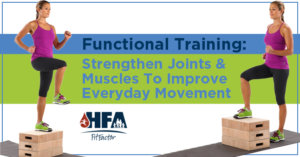 Functional training exercises train your muscles to work together and prepare you for daily tasks by simulating common movements you might do at home, at work or in sports.
Functional training exercises train your muscles to work together and prepare you for daily tasks by simulating common movements you might do at home, at work or in sports.
By using basic movement patterns like pushing, pulling, squatting and carrying, you build stability, strength and mobility that will in turn help with your daily movements. This training is particularly useful for someone with a bleeding disorder as these exercises strengthen the joints and muscles so they function safely and smoothly. They also provide a safer alternative to traditional endurance and strength training when recovering from an injury or bleed.
While using muscles in the upper and lower body at the same time, functional training exercises also activate core stability. A perfect example includes a squat. Squats train your muscles to pick heavy objects from the floor, sitting and standing from a sofa or chair, and enhance your ability to engage in other physical activities that require you to use your legs and core. Squats perform these tasks many times better than knee extensions.
Another benefit of functional training exercises is the fact that you don’t need equipment. Many of these basic exercises can be done using your own body weight. As you use your own body weight during functional training exercises, you also engage multi-joint and multi-muscle exercises that move the elbow, spine, hips, knees and ankles. Not only will it build strength, but it will also improve range of motion. If done properly and safely, you can make everyday activities easier, reduce your risk of injury and improve your quality of life.
Here are a few functional training exercises you can do in the comfort of your own home. If any feel too difficult, painful or uncomfortable, check with your physical therapist or physician for adaptations or alternatives.
Plank
Functionality:Â This simple exercise strengthens the arms and spine, and it also builds core strength. Can be done on the hands or forearms if you have wrist issues.
Exercise:  Come to your hands and knees. Make sure the wrists are under the shoulders. Slowly straighten the legs behind you. As you press the hands in the floor, put more weight on the tips of your fingers, instead of your wrist. Try not to lower your hips and put pressure on the lower back. Engage your core muscles and keep a straight spine. Hold this exercise for 5 to 10 deep breaths. Options: place knees on the floor and hold, or place forearms on the floor.
Wall Sits
Functionality: This exercise builds strength in your quadriceps, core, and glutes. Practicing this exercise makes it easier to get up and down off the floor and to lift heavy objects.
Exercise:Â Pressing spine firmly against a wall, walk feet out and slide backside down so that feet are aligned with knees and knees are over ankles. Keep thighs parallel with the floor without rolling in or out. Press arms firmly into the wall behind you, keeping shoulders back. Click here for variations on the wall sit.
Supported Squat
Functionality: This exercise strengthens your quadriceps, hamstrings, and calf muscles. Squats decrease the incidence of lower back pain.
Exercise:Â Stand with your feet a little more than hip distance apart. If you need support, place your hands on your hips, a counter or use a chair. Slowly bend your knees, concentrating on using the thigh muscle to do the squatting movement. Don’t use momentum, and always push from the heels when you’re trying to squat upwards. Do the slow squatting exercises until you feel the burn, and can no longer squat upwards anymore (Don’t go to the point of pain, however. Stop before you get there).
Step-Ups
Functionality: This exercise focuses on quads, hamstrings and glutes. It helps with balance, stability and posture.
Exercise: Stand tall and raise your right leg to step up onto an elevated platform, like a bench or a step platform. As you step up, raise your left knee to balance against your right leg and hold the position for two seconds. Make sure the platform isn’t too high – your knee shouldn’t be higher than your hip. Repeat for both legs.
Torso rotation
Functionality: Having strong oblique muscles is key in avoiding lower back injuries. This exercise improves the strength and coordination of your core muscles – and will improve your muscle tone and tighten your waist.  This can be done with hands interlace, holding a 3-8-pound book or a medicine ball, if you have one at home.
Exercise:Â Sit on the ground with your knees bent, feet flat on the floor, holding a medicine ball at your chest with both hands. Lean your torso back away from your thighs, increasing the angle at your hips and pulling your belly button in towards your spine. Maintaining your hip angle, rotate your torso to the right, moving your right elbow towards the floor behind you. Return center and rotate to the left. As you get stronger, perform the rotations with straighter arms and/or use a heavier medicine ball. Always keep your belly button pulled in.
As with any new activity, make sure you consult your physician or physical therapist prior to getting started.



